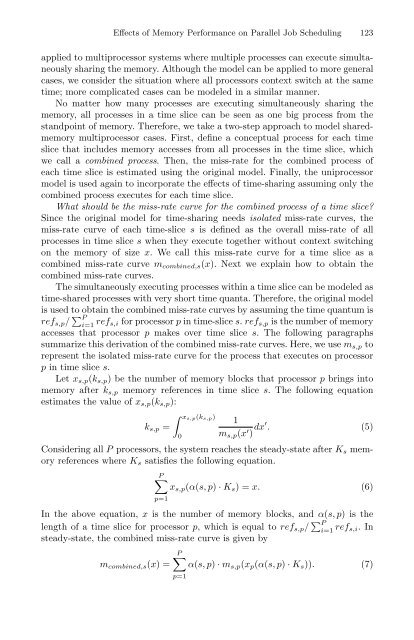LNCS 0558 -Job Scheduling Strategies for Parallel Processing
LNCS 0558 -Job Scheduling Strategies for Parallel Processing
LNCS 0558 -Job Scheduling Strategies for Parallel Processing
You also want an ePaper? Increase the reach of your titles
YUMPU automatically turns print PDFs into web optimized ePapers that Google loves.
Effects of Memory Per<strong>for</strong>mance on <strong>Parallel</strong> <strong>Job</strong> <strong>Scheduling</strong> 123<br />
applied to multiprocessor systems where multiple processes can execute simultaneously<br />
sharing the memory. Although the model can be applied to more general<br />
cases, we consider the situation where all processors context switch at the same<br />
time; more complicated cases can be modeled in a similar manner.<br />
No matter how many processes are executing simultaneously sharing the<br />
memory, all processes in a time slice can be seen as one big process from the<br />
standpoint of memory. There<strong>for</strong>e, we take a two-step approach to model sharedmemory<br />
multiprocessor cases. First, define a conceptual process <strong>for</strong> each time<br />
slice that includes memory accesses from all processes in the time slice, which<br />
we call a combined process. Then, the miss-rate <strong>for</strong> the combined process of<br />
each time slice is estimated using the original model. Finally, the uniprocessor<br />
model is used again to incorporate the effects of time-sharing assuming only the<br />
combined process executes <strong>for</strong> each time slice.<br />
What should be the miss-rate curve <strong>for</strong> the combined process of a time slice?<br />
Since the original model <strong>for</strong> time-sharing needs isolated miss-rate curves, the<br />
miss-rate curve of each time-slice s is defined as the overall miss-rate of all<br />
processes in time slice s when they execute together without context switching<br />
on the memory of size x. We call this miss-rate curve <strong>for</strong> a time slice as a<br />
combined miss-rate curve mcombined,s(x). Next we explain how to obtain the<br />
combined miss-rate curves.<br />
The simultaneously executing processes within a time slice can be modeled as<br />
time-shared processes with very short time quanta. There<strong>for</strong>e, the original model<br />
is used to obtain the combined miss-rate curves by assuming the time quantum is<br />
refs,p/ �P i=1 refs,i <strong>for</strong> processor p in time-slice s. refs,p is the number of memory<br />
accesses that processor p makes over time slice s. The following paragraphs<br />
summarize this derivation of the combined miss-rate curves. Here, we use ms,p to<br />
represent the isolated miss-rate curve <strong>for</strong> the process that executes on processor<br />
p in time slice s.<br />
Let xs,p(ks,p) be the number of memory blocks that processor p brings into<br />
memory after ks,p memory references in time slice s. The following equation<br />
estimates the value of xs,p(ks,p):<br />
� xs,p(ks,p)<br />
1<br />
ks,p =<br />
0 ms,p(x ′ ) dx′ . (5)<br />
Considering all P processors, the system reaches the steady-state after Ks memory<br />
references where Ks satisfies the following equation.<br />
P�<br />
xs,p(α(s, p) · Ks) =x. (6)<br />
p=1<br />
In the above equation, x is the number of memory blocks, and α(s, p) isthe<br />
length of a time slice <strong>for</strong> processor p, which is equal to refs,p/ �P i=1 refs,i. In<br />
steady-state, the combined miss-rate curve is given by<br />
mcombined,s(x) =<br />
P�<br />
α(s, p) · ms,p(xp(α(s, p) · Ks)). (7)<br />
p=1
















